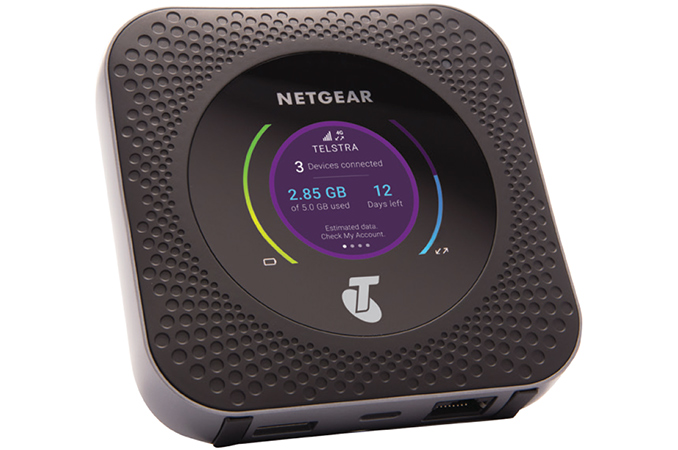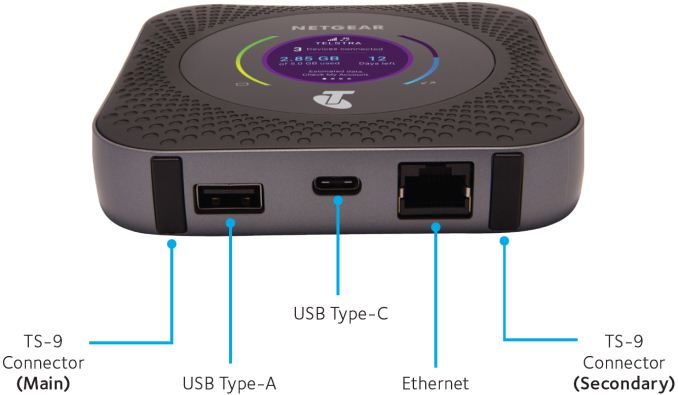Netgear Nighthawk M1: LTE Cat 16 Router up to 1 Gbps
by Anton Shilov on February 2, 2017 12:01 PM EST
Netgear this week announced the Nighthawk M1 mobile router, which is the industry’s first 4G LTE device with download speed up to 1 Gbps. The Nighthawk M1 is powered by Qualcomm’s X16 LTE modem with 4x4 MIMO announced a year ago and will be available only on Telstra’s 4GX LTE network in Australia. As soon as similar networks are launched in different parts of the world, the same router or its derivatives may hit the market elsewhere as well.
The Netgear Nighthawk M1 mobile router is aimed at those who need to set up ultra-fast mobile broadband connection for multiple people and up to 20 devices in areas where cable broadband is unavailable (there are a lot of rural areas in Australia where there is no broadband). The Nighthawk M1 can be used like a normal portable router (it has a GbE port as well as two USB headers) or as a NAS/media streamer (it has a microSD slot). The router also has an inbuilt battery (5040 mAh) which is rated for up to 24 hours of standard use. The Nighthawk M1 does not require any special setup, but it is equipped with a 2.4” display to monitor its performance/data usage and there is also a special app for Android and iOS that allows a user to manage the router (network settings, parental controls, etc.).
At the heart of the Netgear Nighthawk M1 there is Qualcomm’s Snapdragon X16 LTE modem (paired with Qualcomm’s WTR5975 RF transceiver). The modem supports 4x4 MIMO, four carrier aggregation (4xCA) and higher order modulation (256QAM) to download data at up to 1 Gbps (in select areas) as well as 64QAM and 2CA to upload data at up to 150 Mbps over Telstra’s 4GX LTE network (Telstra's network is only 3CA it is worth noting). We already know that the X16 modem will be integrated into Snapdragon 835 SoCs for smartphones, but right now it is available only as a standalone chip. The Nighthawk M1 router is also equipped with Qualcomm’s 2×2 802.11 b/g/n/ac Wi-Fi solution that can connect up to 20 devices simultaneously using 2.4 GHz and 5 GHz bands concurrently.
| Netgear Nighthawk M1 MR1100 | |
| SoC | Qualcomm Snapdragon X16 LTE modem MDM9x50 |
| Display | 2.4" |
| Network | 4G: 4GX LTE CAT 16, 4-band CA, 4x4 MIMO 700/900/1800/2100/2600 MHz 3G: 850/900/1900/2100 MHz |
| LTE | Down: 1000 Mb/s Up: 150 Mb/s |
| Dimensions | 105.5 × 105.5 × 20.35 mm |
| Weight | 240 grams |
| Battery | 5040 mAh (removable) |
| Connectivity | 2×2 802.11 b/g/n/ac Wi-Fi for up to 20 devices |
| External Ports | Ethernet USB-A USB-C 2 × TS-9 connectors for external antennas |
| Storage | MicroSD card with media server/NAS capabilities |
| SIM Size | unknown |
| Colors | Grey |
| Launch Country | Australia |
| Price | $360 AUD ($276 USD) |
The Netgear Nighthawk M1 (MR1100) mobile router will be available from Telstra in Australia later this month for $360 AUD ($276 USD) standalone. Telstra also plans to offer the router with a range of broadband plans.
Related Reading:
Source: Netgear














50 Comments
View All Comments
ajp_anton - Friday, February 3, 2017 - link
A big city of 5M should be easier to give mobile internet to than 5M people spread out over a large area.Also, I don't really see why a country of 50M people couldn't work like 10 smaller 5M-people countries. It might be more difficult to coordinate everything for 50M people at the same time, but on the other hand there's a lot more resources to do so, and a lot more customers. And you could do it in smaller "5M people steps".
Finland has been on the "cutting edge" of mobile internet since pretty much the beginning, and has constantly replaced the old with the newest.
No, I don't have 1Gbit/s. Personally I only want to pay 10€ for 50Mbit/s, but you can get 300Mbit/s for a lot more money.
close - Friday, February 3, 2017 - link
Well the math for this doesn't really scale like that. For one, Finland's total mobile traffic for 2015 was ~650000TB and we can assume it increased in 2016. 10 times the population would imply 650PB of mobile traffic. For the US (60+ times larger) it might mean 40 million TB or mobile traffic.All great until you realize costs don't scale linearly. Also some countries for example don't allow installing additional mobile towers in cities so the only way to increase capacity is to always use the cutting edge (and very expensive) technology for infrastructure.
fanofanand - Thursday, February 9, 2017 - link
He answered your question already "(mine is capped at 50/30 Mbit/s)"Vatharian - Friday, February 3, 2017 - link
I have unlimited LTE bandwidth with my current operator, but you're right, it gets throttled to 50 Mbps after first 100GB downloaded. I pay 7€/mo and I can lift the throttle limit to 500GB with 4.5€.Oh, Europe.
close - Friday, February 3, 2017 - link
Vatharian, just western Europe apparently. Eastern, Central, and Northern Europe look like they have plenty of "unlimited data" plans for reasonable prices but as far as I can tell all of them have throttling after a limit.tyger11 - Thursday, February 2, 2017 - link
Complaining about that is missing the point. Are you suggesting people should only have connection speeds that match their monthly data cap? If you're going to download half of your monthly allotted data per month, why shouldn't you be able to do that as quickly as possible? I've never hit my data cap, but it's crazy that I would want to wait any longer than necessary for things to download.close - Friday, February 3, 2017 - link
There must be some sort of correlation in situations where you have a limited data. Think of the correlation between engine and fuel tank in cars. A Ferrari will have an 80-100l tank, while a Fiesta does away with 40l.It's one thing to gave 1Gbps over unlimited fiber connections, quite another to have it over a metered one that gets exhausted in seconds. Assuming you even reach those speeds which I doubt.
Over a limited connection increasing speed brings severely diminished returns. So on a 30GB plan (Telstra's highest on their website) the difference between 100Mbps and 1000Mbps is... 36 minutes over the course of a month.
So until you have reasonable data plans in the hundreds of GBs at a reasonable price, and the network can actually deliver it not just on paper I stand by my "usability" statement.
Meteor2 - Friday, February 3, 2017 - link
It seems utterly bizarre to launch such a device. Your fuel tank analogy is very good.Maybe Telstra are going to roll out some new plans which, well, make sense?
ZeDestructor - Friday, February 3, 2017 - link
Knowing Tesltra, highly unlikely.StevoLincolnite - Saturday, February 4, 2017 - link
The thing with Australian Mobile internet is that... We don't have many cell towers packed closely together, so there are more users per-tower overall.It also allows a company like Telstra to have one of the largest LTE networks in the world in regards to sheer amount of land coverage as they can space the towers out.
But to counter the higher user ratios, they need higher LTE speeds to compensate, which is why Telstra has led the world since 3G in adopting the fastest mobile technologies.
It's much cheaper for Telstra to upgrade the towers and advertise their new shiny speed than it is to build more towers and more backhaul links... And then they can sell you "Data Packs" to top up your data when you run out. Win win.
****
With that said, this Anandtech is also incorrect.
Australia has almost complete Broadband coverage thanks to wide-beam satellite.